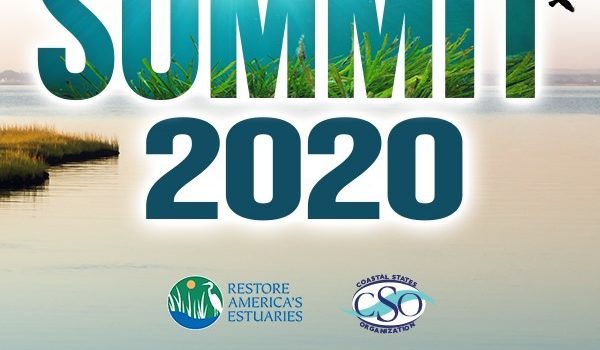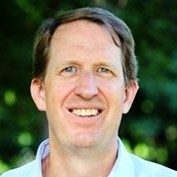
Reflections on the 2020 National Coastal & Estuarine Virtual Summit
Solutions driven approach produces most successful Summit to date
By Daniel Hayden
It’s hard to believe the 2020 Summit has already come and gone. After two years of planning, a leap into a virtual platform, and a lot of trust, you produced three days of enlightening conversation and more than 500 solutions–focused presentations. On behalf of the entire Summit planning team, thank you for helping make this year’s Virtual Summit a reality.
Five months ago, I took o ver as President of Restore America’s Estuaries. I was eager to meet with our great partners and hear about your excellent work in person. Instead, Covid-19 forced us to reconsider the format, objectives, and overall purpose of this event. Up to the very second before we began the opening plenary, we still didn’t know what to expect.
ver as President of Restore America’s Estuaries. I was eager to meet with our great partners and hear about your excellent work in person. Instead, Covid-19 forced us to reconsider the format, objectives, and overall purpose of this event. Up to the very second before we began the opening plenary, we still didn’t know what to expect.
Despite all of that, you showed up. Almost 1,500 of you, in fact. You arrived willing and ready to explore solutions, build new partnerships, and enjoy the camaraderie the Summit has become famous for since its inception in 2003. Despite the virtual format and less-than-ideal circumstances, I can honestly say this was our most successful Summit to date.
As we reflect on last week’s success, it would be a shame not to recognize a few partners who helped us along the way.
First, our lead partners in this year’s Summit, Save the Bay – Narragansett Bay and Coastal States Organization (CSO). It would be impossible to pull off an event of this magnitude alone, and Save the Bay and CSO went above and beyond.
Secondly, our sponsors deserve so much credit for their support of this event. Truly, we could not have moved forward without the trust and financial commitment from NOAA and Orsted and the 50+ private, public, and non-profit entities that truly believe in the importance of the Summit and the future of coastal restoration and management.
Third, a huge thank you to Capital Meeting Planning for keeping us on task and seamlessly arranging all the digital and audio content. Thank you for being two steps ahead of us and supporting us through the process.
Last, and certainly not least, thank you to the more than 350 presenters for sharing your insights, ideas, and lessons learned. There’s no doubt that without the science– based content and professional credibility you bring to the agenda, there would be no Summit.
This year, we also had the opportunity honor our friends at EPA and NOAA, who are both celebrating their 50th birthday. The leadership, coordination, and guidance from all our federal government partners only strengthens our ability to tackle the complex coastal issues facing our country today. If you didn’t get a chance, check out the Happy Birthday video we put together to recognize the occasion.
You may have also noticed an increased focus on diversity, equity, and inclusion at this year’s Summit. For too long, too many people have been left out of conversations and decision making that directly impact them. Tribal lands have been stolen under the guise of progress, communities of color put in harm’s way, and traditional ways of life and legacy ignored. We have a long way to go, but I hope this year’s Summit contributed to turning back the indifference and ignorance that enabled so many misdeeds.
We heard from John Brown, Medicine Man for the Narragansett Tribe, and Queen Quet, Chieftess of the Gullah/Geechee Nation, talk about how their ancestral homes and traditional ways of life are under siege from climate change, rising sea levels, and over–harvest of fish and wildlife. We also learned from the Avarna Group, Majora Carter, and Nicole LeBoeuf, Acting Assistant Administrator for NOAA – National Ocean Service, on how we as a community can improve our outreach strategies and break down our biases to make conservation and our estuaries more inclusive and equitable. Let’s put their messages to work.
I also want to acknowledge the Curtis & Edith Munson Foundation, the Honda Marine Science Foundation, and The Island Foundation for providing scholarships to historically underrepresented groups to attend the 2020 Summit. We were fortunate to have students from HBCU’s and tribal colleges, early career professionals, and other members of our diverse community attend the Summit and provide their unique perspective and experience to the conversation. Let’s bring these professionals into our networks and organizations.
Thank you as well to The Honda Marine Science Foundation and The Island Foundation for donating expo hall space so that groups such as Brown Girl Surf and Corazón Latino had the opportunity to promote their great work. Let’s build more expansive, inclusive, and better partnerships with all stakeholders.
Just as biodiversity in an estuary improves the overall health and productivity, so do diverse stakeholders contribute to higher success and long-term sustainability in coastal and estuary management. It is up to us to make this happen.
As we prepare for the next Summit in 2022, RAE plans to build on our commitment to make the Summit more accessible. Although we plan to meet in person again (hopefully), we’ve embraced the value of on-demand digital content and plan to make that a part of future Summits. By pursuing this hybrid model of live and virtual presentations, we can break down some of the barriers to participation that have plagued too many of our community members for far too long.
In closing, I’d like to reflect on the words from the Congressional Estuaries Caucus. Representatives Suzanne Bonamici, Brian Mast, Bill Posey, and Rick Larsen have laid the groundwork for success in achieving our nation’s estuary restoration goals. To paraphrase sentiments: resilient coasts, clean water, intact habitats, and healthy estuaries are not a partisan issue, but rather provide economic, ecologic, and recreational benefits to all of us, regardless of political party, race, religion, or socioeconomic status.
So, here’s to seeing you all again in two years. I can’t wait to celebrate more milestones, more success stories, and more solutions. Until then, enjoy the on-demand presentations and virtual expo hall which will be open until May of 2021.
Cheers!
Want to stay up to date on the 2022 Summit? Sign up for our free newsletter!
 Daniel Hayden is the President and CEO of Restore America’s Estuaries. He is based in Arlington, VA.
Daniel Hayden is the President and CEO of Restore America’s Estuaries. He is based in Arlington, VA.
